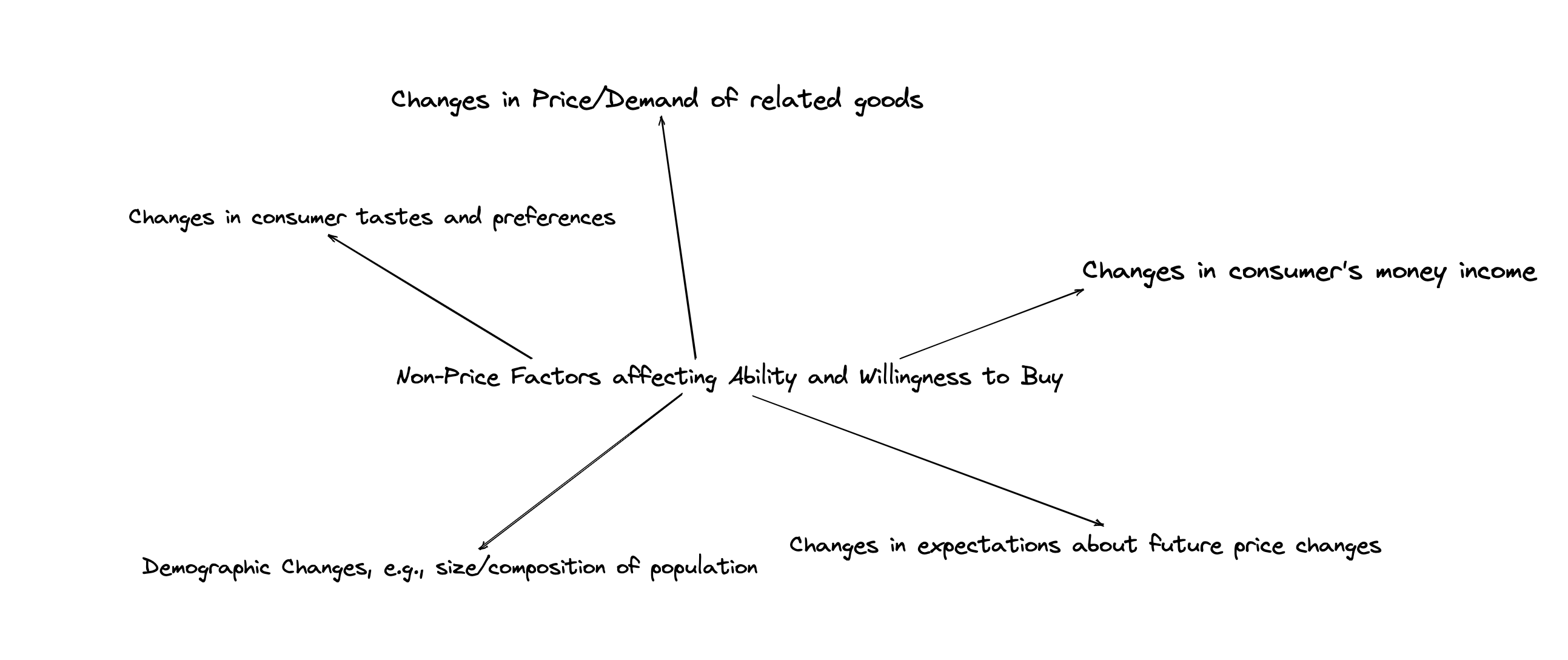Markets
- Where Buyers and Sellers meet in order to exchange money for goods
- They do not always meet in person
- Goods can be bought by consumers and sold by suppliers in online markets, e.g., Amazon
- Amount of money a consumer pays the supplier in exchange for a good/service is called the price*
- There are markets for the factors of production
- Labour is needed by producers to make goods
- The producers are the buyers of labour and individual people are the sellers of their own labour
Product Markets
- Product markets deal with the buying/selling of goods and services
- Consumers represent the demand side of the market, while producers/firms represent the supply side
- Firms produce goods and services and sell them to households (consumers)
Factor Markets
- Deal in the buying and selling for factors of production or resources
- E.g., labour market
- In a factor market, households sell their resources to firms
- Households represent the supply side of the market
- Firms represent the demand side
Markets can also be classified according to the intensity of competition in the market
Competitive Markets
- Large number of buyers and sellers
- Firms are price takers (no power over price), must take price established by market
- Very similar (homogenous) products
- Easy entry into market (no barriers to entry or exit)
- Price is determined by the interaction between buyers and sellers
- No individual buyer or seller can influence the market price
- No market power
Imperfect Market
- Not competitive
- A.k.a. non-competitive market
- Small number of firms
- Product differentiation
- Firms are price setters, can set their own price
- They have market power
- Entry into market is restricted (barriers to entry), makes it harder to have competition
- E.g. Mobile Phones, Water Corporation
- Monopoly, Oligopoly
- Monopoly: One seller or producer is the sole supplier of a good/service in a market
- Oligopoly: Small number of firms, none of which can keep the others from having significant influence. I.e., a few sellers/producers are the sole suppliers of a good/service in a market
- Firms try to make their products look “different” in their consumer’s eyes
Demand
- Amount of a good/service consumers are willing and able to buy in a given period of time at a given price, ceteris paribus
- Ceteris paribus: other things remaining constant
- A.k.a. effective demand
- Law of Demand: Quantity demanded of a product is inversely related to its price, in a given period of time, ceteris paribus
- Individual Demand:**** Demand for a good or service by an individual consumer
- Market Demand: Sum of the individual demand for a good or service by all of the consumers in the market

 Non-Price Factors affecting Ability and Willingness to buy
Non-Price Factors affecting Ability and Willingness to buy
- Shifts demand curves left/right
- Demographic Changes, e.g. size/composition of population
- Changes in expectations about future price changes
- Changes in Consumer’s Money income
- Changes in Price/Demand of related goods
- Changes in consumer tastes and preferences
Changes in Price/Demand of Related Goods
Substitutes
- Alternative product that can replace another because it satisfies the same want
- A.k.a. competitive demand
- If the price of one good changes, the demand for the substitute good will change in the same direction
Complements*
- Complementary products must be used at the same time with another to satisfy the same human wants
- A.k.a. joint demand
- Separate products, but are consumed at the same time
- If the price of one good changes, the demand for the complementary good will change in the opposite direction
Goods in Derived Demand*
- When a good is in derived demand, it is demanded for its contribution to the manufacture of another product
- Usually raw materials, e.g. wood
- For 2 goods in derived demand, a change in demand for the final good causes a similar change in demand for the resource used to produce it
Changes in Consumer’s Money Income
Normal Goods*
- A good is a normal good when demand for it increases in response to an increase in consumer income
- Demand for the good varies directly with income
- Most goods are normal goods
- Luxury goods, necessities
- Increase in income leads to a rightward shift in the demand curve, and vice versa
- Purchasing power increases with income, therefore demand increases
*Inferior goods
- Goods where the demand falls as consumer income increases and vice versa
- E.g., cheaper alternatives, like flying with JetStar instead of Singapore Airlines
- Demand for the good varies inversely with income
- As income increases, consumers switch to more expensive alternatives, so the demand for the inferior good falls
- Relative to wants
- Increase in income leads to a leftward shift in the demand curve, and vice versa
- When income changes, demand will change in the opposite direction
Changes in Consumer Tastes and Preferences
- The more desirable a good is to consumers, the higher the demand, and vice versa
- Tastes and preferences are affected by advertisements, pop star appeal, age, peers, etc
- Advertisement campaigns
Demographic Changes
- Changes in size/composition of population
- E.g., Age, if you are old, you will buy less athletic goods
Changes in Expectations about Future Price Changes
- If the price is expected to increase, demand will increase, so they have more purchasing power before the increase in price
- Demand curve shifts to the right
- Vice versa
Upward-Sloping Demand Curve
- Ostentatious goods
- E.g., Luxury items, cars, watches
- Price is directly related to quantity demanded
- Higher price is perceived as higher quality, resulting in more being bought